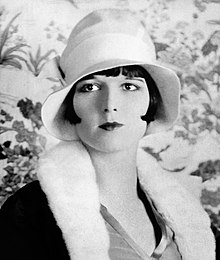
Back Louise Brooks Afrikaans لويز بروكس Arabic لويز بروكس ARZ Louise Brooks AST لوئیز بروکس AZB Louise Brooks Breton Louise Brooks Catalan Louise Brooks German Louise Brooks Esperanto Louise Brooks Spanish
Louise Brooks | |
|---|---|
 Brooks c. 1926 | |
| Born | Mary Louise Brooks November 14, 1906 Cherryvale, Kansas, U.S. |
| Died | August 8, 1985 (aged 78) Rochester, New York, U.S. |
| Resting place | Holy Sepulchre Cemetery (Rochester, New York) |
| Other names | Lulu, Brooksie, The Girl in the Black Helmet |
| Occupations |
|
| Years active | 1925–1938 |
| Known for | Pandora's Box (1929) Diary of a Lost Girl (1929) |
| Spouses | |
Mary Louise Brooks (November 14, 1906 – August 8, 1985) was an American film actress during the 1920s and 1930s. She is regarded today as an icon of the flapper culture, in part due to the bob hairstyle that she helped popularize during the prime of her career.[1][2][3]
At the age of 15, Brooks began her career as a dancer and toured with the Denishawn School of Dancing and Related Arts where she performed opposite Ted Shawn.[4] After being fired, she found employment as a chorus girl in George White's Scandals and as a semi-nude[5] dancer in the Ziegfeld Follies in New York City.[5][6] While dancing in the Follies, Brooks came to the attention of Walter Wanger, a producer at Paramount Pictures, and signed a five-year contract with the studio.[5][7] She appeared in supporting roles in various Paramount films before taking the heroine's role in Beggars of Life (1928).[8] During this time, she became an intimate friend of actress Marion Davies and joined the elite social circle of press baron William Randolph Hearst at Hearst Castle in San Simeon.[9][10]
Dissatisfied with her mediocre roles in Hollywood films, Brooks went to Germany in 1929 and starred in three feature films that launched her to international stardom: Pandora's Box (1929), Diary of a Lost Girl (1929), and Miss Europe (1930); the first two were directed by G. W. Pabst. By 1938, she had starred in 17 silent films and eight sound films. After retiring from acting, she fell upon financial hardship and became a paid escort.[11] For the next two decades, she struggled with alcoholism and suicidal tendencies.[12][13] Following the rediscovery of her films by cinephiles in the 1950s, a reclusive Brooks began writing articles about her film career; her insightful essays drew considerable acclaim.[11][14] She published her memoir, Lulu in Hollywood, in 1982.[14][15] Three years later, she died of a heart attack at age 78.[16]
- ^ Corliss 2006.
- ^ Garebian 2011, p. 142.
- ^ Lipton & Minnelli 2006.
- ^ Brooks 1982, pp. 8–11.
- ^ a b c Brooks 1966.
- ^ Brooks 1982, p. 17.
- ^ Paris 1989, p. 100.
- ^ Brooks 1982, pp. 22–23.
- ^ Brooks 1982, pp. 34–35.
- ^ Tynan 1979, p. 72.
- ^ a b Ebert 1998.
- ^ Brooks 1982, p. 38.
- ^ Paris 1989, p. 423.
- ^ a b Wahl 2016, p. 1.
- ^ Brooks 1982.
- ^ Mitgang 1985.